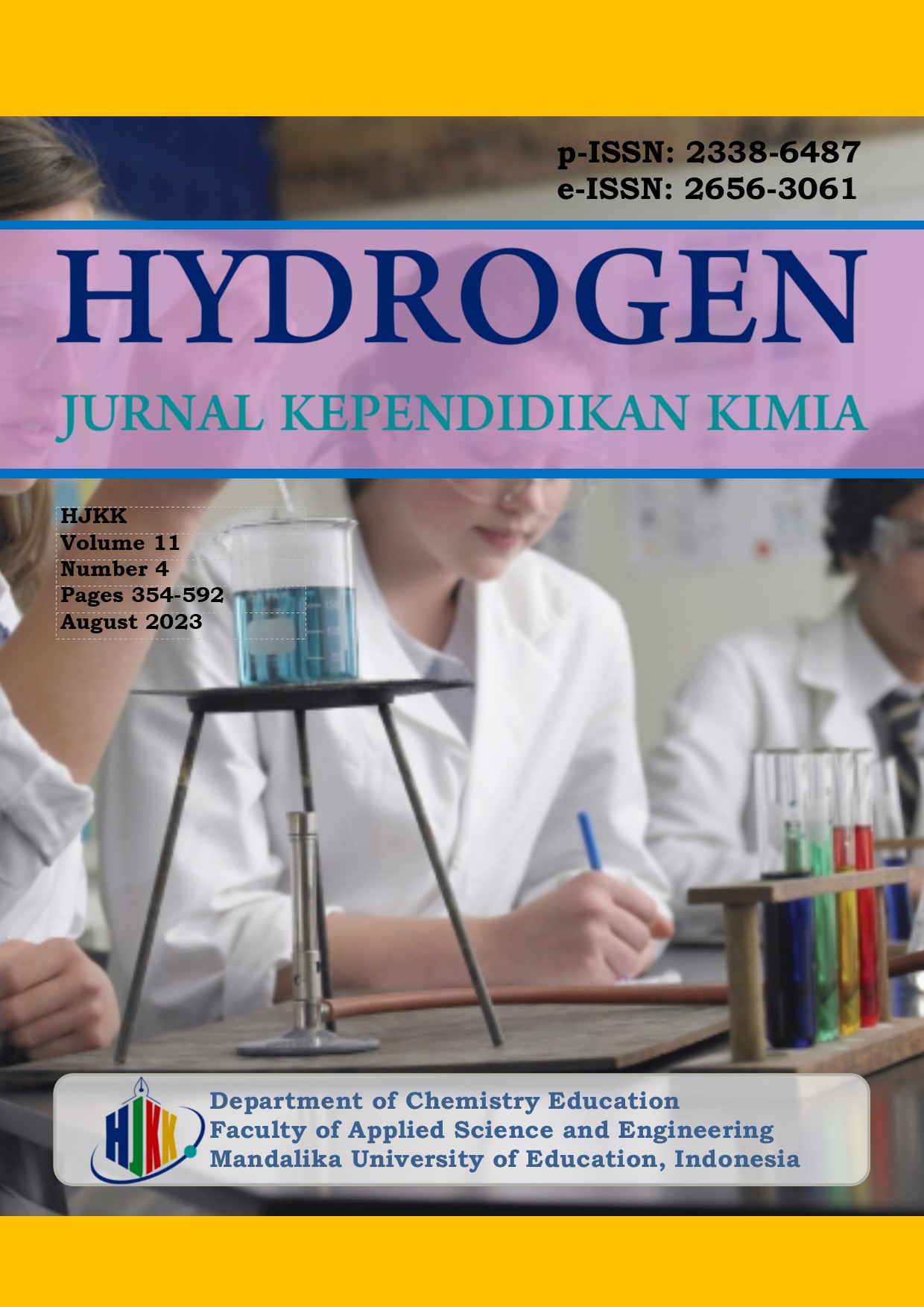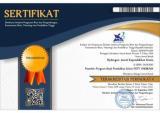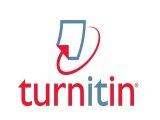Atomic Structure Teaching Module with PhET Simulation to Increase Student Motivation and Learning Outcomes
DOI:
https://doi.org/10.33394/hjkk.v11i4.8436Keywords:
module, PhET, motivationAbstract
This study aims to obtain the feasibility of teaching modules with PhET simulations to increase student motivation and learning outcomes in atomic structure content as a learning tool. The eligibility of teaching modules consists of valid, practical, and effective criteria. This development research uses the ADDIE research model which consists of five stages which include analysis, design, development, implementation, and evaluation. The trial design used was the One Group Pretest-Posttest Design. The subjects in this study were students of class X SMA Intensif Taruna Pembangunan Surabaya with a total of 30 students. The research instruments used included validation sheets, student response sheets, student activity observation sheets, learning motivation sheets and pretest-posttest sheets. Analysis of the data used using the validity test, analysis of the percentage of practicality and the percentage of effectiveness. The results of the validity test obtained a validation mode score of 4 so can be stated that the teaching modules developed are included in the good category. The results of the practicality test obtained the percentage of students' response results of 82.3% so can be stated that the teaching modules developed are categorized as very practical. Then the percentage of the effectiveness of motivation to learn before treatment obtained results of 50.6% and after treatment of 85.7%. Based on these percentages, it can be stated that the teaching modules created can increase students' learning motivation. The learning outcomes of students obtained an N-Gain score of 0.71 which means that the teaching module is in the high category.
References
Aprilia, N. L., & Lutfi, A. (2023). Ethnoscience-Based Interactive Multimedia to Improve Scientific Literacy in Chemical Equilibrium Materials. Hydrogen: Jurnal Kependidikan Kimia, 11(3), 242–252.
Cresswell, J. W., & Cresswell, J. D. (2018). Research Design Qualitative, Quantitative, and Mixed Methods Approaches. Journal of Chemical Information and ModelingChemical Information and Modeling, 53(9).
Desi, D., & Lumbantoruan, J. H. (2020). Pengembangan Buku Cerita Matematika Pada Kelas VII SMP dalam Materi Perbandingan. Jurnal Pendidikan, Matematika Dan Sains, 1(1), 23–34.
Ekawati, Y., Haris, A., & Amin, H. (2015). Penerapan Media Simulasi Menggunakan PhET (Physics Education And Technology) Terhadap Hasil Belajar Fisika Peserta Didik Kelas X SMA Muhammadiyah Limbung. Jurnal Pendidikan Fisika, 17(3).
Finkelstein, Adam, Perkins, Podolefsky, Dubson, & Weiman. (2005). A New Instrument for Measuring Student Beliefs About Physics and Learning Physics: the Colorado Learning Attitudes about Science Survey. Physics Education Research. USA: University of Colorado.
Haerana, H. A., Ramlawati, & Yunus, S. R. (2020). Media simulasi PhET berpengaruh terhadap peningkatan hasil belajar peserta didik. Jurnal Pijar MIPA, 15(2).
Hake, R. R. (1998). Interactive-engagement versus traditional methods: A six-thousand-student survey of mechanics test data for introductory physics courses. American Journal of Physics, 64.
Ilma, K., & Lutfi, A. (2020). Penerapan PhET Sebagai Media Pembelajaran Struktur Atom dan Sistem Periodik di SMK Nahdlatul Ulama Sugio Lamongan. UNESA Journal of Chemical Education, 9(3), 309–316.
Jamal, F. (2014). Analisis Kesulitan Belajar Siswa Pada Materi Peluang | 18. Jurnal MAJU (Jurnal Pendidikan Matematika), 1(1), 18–36.
Kartiani, B. S. (2015). Pengaruh Metode Pembelajaran dan Motivasi Belajar Terhadap Motivasi Belajar. Jurnal Pendidikan Dasar, 6(2), 212–221.
Khoirurrijal, Fadriati, Sofia, Makrufi, A. D., Gandi, S., Muin, A., Tajeri, Fakhrudin, A., Hamdani, & Suprapno. (2022). Pengembangan Kurikulum Merdeka. Malang: Literasi Nusantara Abadi.
Lidra, I. A., Mawarnis, E. R., & Herman, M. (2022). Development of student worksheet based on discovery learning istining. Hydrogen: Jurnal Kependidikan Kimia, 11(April), 207–216.
Lutfi, A. (2021). Research and Development (R&D): Implikasi dalam Pendidikan Kimia. Surabaya: Jurusan Kimia FMIPA Universitas Negeri Surabaya.
Lutfi, A., & Hidayah, R. (2021). Gamification for Science Learning Media: Challenges of Teacher and Expectations of Students. International Journal of Interactive Mobile Technologies, 15(1), 142–154. doi: 10.3991/IJIM.V15I01.15175
Lutfi, A., Hidayah, R., Aftinia, F., & Ipmawati, N. (2023). House of Chemistry as a hydrocarbon learning media for high school students. Educacion Quimica, 34(1), 176–187. doi: 10.22201/fq.18708404e.2023.1.82798
Maulida, U. (2021). Pengembangan Modul Ajar Berbasis Kurikulum Merdeka. Pendidikan Tambusai, 5(1), 1617–1620.
Mulyatiningsih, E. (2016). Pengembangan Model Pembelajaran. Retrieved from http://staff.uny.ac.id/sites/default/files/pengabdian/dra-endang-mulyatiningsih-mpd/7cpengembangan-model-pembelajaran.pdf
Muzana, S. R., & Astuti, D. (2017). Penerapan Pembelajaran Berbasis PhET Simulations untuk Meningkatkan Pemahaman Konsep Fisika Inti pada Siswa SMA. SEMDI-UNAYA, 409–417.
Purwandani, Nugroho, A., Lutfi, A., & Hidayah, R. (2019). The Development of Chem Man Computer Game as Atomic Constituent Particles Learning Media For 10th Grade High School. Unesa Journal of Chemical Education, 8(3), 380–389.
Sariwati, L. N., Sunaryo, A., & Sukarmin. (2023). Meningkatkan Hasil Belajar Peserta Didik dengan Model Discovery Learning pada Materi Ikatan Kimia. Jurnal Pendidikan Kimia FKIP Universitas Halu Oleo, 11(June), 14–23.
Viani. (2017). Perbandingan Hasil Belajar Peserta Didik Menggunakan Media Chemopoly Permainan Dan Tournament Question Cards. Jurnal Pendidikan Kimia, 1(1), 55–59.
Yusuf, M. (2016). Deskripsi Simulasi PhET Terhadap Motivasi Belajar Siswa Pada Mata Pelajaran Fisika. Gorongtalo: UNG Repository.
Downloads
Additional Files
Published
How to Cite
Issue
Section
Citation Check
License
License and Publishing Agreement
In submitting the manuscript to the journal, the authors certify that:
- They are authorized by their co-authors to enter into these arrangements.
- The work described has not been formally published before, except in the form of an abstract or as part of a published lecture, review, thesis, or overlay journal.
- That it is not under consideration for publication elsewhere,
- That its publication has been approved by all the author(s) and by the responsible authorities – tacitly or explicitly – of the institutes where the work has been carried out.
- They secure the right to reproduce any material that has already been published or copyrighted elsewhere.
- They agree to the following license and publishing agreement.
Copyright
Authors who publish with Hydrogen: Jurnal Kependidikan Kimia agree to the following terms:
- Authors retain copyright and grant the journal right of first publication with the work simultaneously licensed under a Creative Commons Attribution License (CC BY-SA 4.0) that allows others to share the work with an acknowledgment of the work's authorship and initial publication in this journal.Â
- Authors are able to enter into separate, additional contractual arrangements for the non-exclusive distribution of the journal's published version of the work (e.g., post it to an institutional repository or publish it in a book), with an acknowledgment of its initial publication in this journal.
- Authors are permitted and encouraged to post their work online (e.g., in institutional repositories or on their website) prior to and during the submission process, as it can lead to productive exchanges, as well as earlier and greater citation of published work.
Licensing for Data Publication
Hydrogen: Jurnal Kependidikan Kimia uses a variety of waivers and licenses, that are specifically designed for and appropriate for the treatment of data: Open Data Commons Attribution License, http://www.opendatacommons.org/licenses/by/1.0/ (default) Other data publishing licenses may be allowed as exceptions (subject to approval by the editor on a case-by-case basis) and should be justified with a written statement from the author, which will be published with the article.










